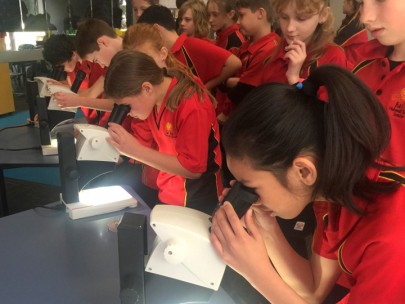Halswell School, Canterbury
In this section
-
Participating schools
- Curious Minds visit Lincoln
- Franz Josef & Fox Glacier Schools
- Greymouth High School
- Haast School
- Halswell Domain
- Halswell School
- Heathcote Valley School
- Kaniere School
- Kaniere visit Lincoln
- Hokitika Primary
- Leeston Consolidated School
- Manuka Primary School
- Mission Heights
- Mt Albert Grammar
- Paroa School
- Rudolf Steiner School
- Takapuna Grammar
- TKKM
- Wakaaranga Primary School
- Whataroa School

Halswell School students studying tradescantia beetles. Image: Suzette Howe
In 2018 we made three successive visits to teach the Y6 classes, co-ordinated by Lisa Dovey, the schools’ Y6–8 Team Leader. Class teachers who joined us each Thursday were Jade Smith (21st June, with 23 students), Leanne Spicer (28th June, 20 students) and Jeneane Jefferson (5th July, 26 students).
Robinne Weiss, our Canterbury-based educator joined us. Robinne developed the classroom-based weed activity resources that we use.
Each of the mornings, Robinne led the classes through activities that included jig-saw puzzles (each profiling a different weed, with their impacts and invasion strategies), designing a ‘dream garden’ (a creativity exercise resulting in discussion of why plants were chosen by students and what their values are), and a web-of-life exercise (where students each have labels of native and exotic plants and animals, and we connect everyone together using string to show ecological relationships). We also taught seed dispersal and brought along microscopes with different types of seed for the students to look at – looking down microscopes at interesting objects is always very popular!
The focus of our 2018 Canterbury delivery is weeds of waterways, and Robinne and Murray Dawson brought along several plants to discuss with the students what they are, how they came to New Zealand, what they were used for, and why they are weedy. This show-and-tell included gorse (Ulex europaeus), broom (Cytisus scoparius), arum lily (Zantedeschia aethiopica), couch grass (Cynodon dactylon), periwinkle (Vinca major), sow thistle (Sonchus oleraceus), and yarrow (Achillea millefolium). Robinne also gave the students watercress (Nasturtium) leaves to taste.
Murray then discussed the different types of weeds, including common garden weeds, environmental weeds, and National Pest Plant Accord species now banned from sale. Weeds of waterways were highlighted, including purple loosestrife (Lythrum salicaria), spartina (Spartina anglica), and the new to NZ invasive weed of wetlands, great willowherb (Epilobium hirsutum).
Biocontrol expert Hugh Gourlay joined us for each afternoon. He spoke to the students about biocontrol, host testing, and his travels around the world collecting biocontrol agents. Hugh brought along some tradescantia beetles to look at and identify under the microscopes – the leaf beetle ‘Shiny’ (Neolema ogloblini), the stem beetle ‘Knobbly’ (Lema basicostata), and the tip beetle ‘Stripy’ (Neolema abbreviata).
We found a small patch of tradescantia growing along a streamside near the school, in Muir Park, for the students to release the biocontrol beetles on to. Due to the colder southern climate, tradescantia is a lot less common in Canterbury than northern areas such as Auckland. Sure enough, on our second visit to the Halswell site, the low lying foliage had been frosted off, leaving healthy tradescantia foliage scrambling up a shrub where it is more protected from frost.
What were some of the plants that we found?
Around Muir Park, and walking back to the school, we collected and recorded weeds and several cultivated plants using the iNaturalist smartphone app.
Our time was too short (and the ground too wet at this time of year) to collect more widely, such as in Halswell Quarry Park a few km’s down the road. Hence, the students made repeat observations of common weed species, including:
- tradescantia (Tradescantia fluminensis)
- broad-leaved dock (Rumex obtusifolius)
- common daisy (Bellis perennis)
- common ivy (Hedera helix)
- Franchet’s cotoneaster (Cotoneaster franchetii)
- petty spurge (Euphorbia peplus)
- two arums spreading around – Italian Arum (Arum italicum) and arum lily (Zantedeschia aethiopica)
- wild plum or cherry (genus Prunus).
Nevertheless, more than 110 observations were made of more than 40 species which is a great effort.
Ivy is still widely cultivated in New Zealand, and we saw first-hand how quickly it can grow out of control and spread into new areas.
Further afield from our walking route, Murray recorded gorse and European spindle tree (Euonymus europaeus), both environmental weeds and likely originally planted as part of nearby semi-rural hedging and shelter belts.
Also see our:
- Facebook note of our visits to Halswell School
- May 2019 field trip with the school to Halswell Domain
Funding
The visits were made possible by funding from Unlocking Curious Minds (UCM) and the Brian Mason Trust.











